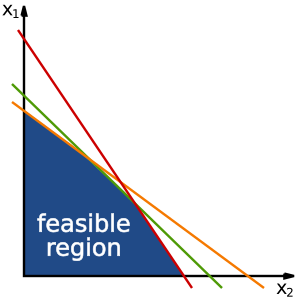Linear programming facts for kids
Linear programming (also called linear optimization) is a part of mathematics. It helps us find the best possible answer to problems that can be described using straight lines and simple rules. Often, this means finding the smallest or largest value for something, while following certain conditions or limits.
For example, linear programming can help plan traffic flows to make them smoother. It's a key tool in a field called Operations research, which uses math to make better decisions. It's also a special type of Convex optimization. Linear programming can even help solve problems in Integer programming, which deals with whole numbers. Sometimes, the solutions can be seen as shapes like polyhedra, which helps solve problems using geometry.
The word "programming" here means "planning," not computer coding. George Dantzig first used the term in the 1940s, long before computers were common. Linear programming problems are usually easy for computers to solve quickly. Algorithms like the interior point method are very efficient. The Simplex algorithm, also created by Dantzig, is often very fast, even if it can be slow in some rare cases.
Leonid Kantorovich developed the first ideas for linear programming in 1939.
Contents
What is Linear Programming?
Linear programming helps us make the best choices when we have limited resources or certain rules to follow. Think of it like trying to get the most out of something (like profit) or spend the least (like cost).
Finding the Best Solution
Imagine you own a bakery. You want to make as much money as possible. You have a limited amount of flour, sugar, and eggs. You also know how much each cake and cookie sells for. Linear programming can help you figure out the exact number of cakes and cookies to bake to get the biggest profit, without running out of ingredients.
Rules and Limits (Constraints)
In linear programming, the "rules" or "limits" are called constraints. These are like boundaries that you cannot cross. For example, you might have a constraint that says you can't use more than 100 pounds of flour. These constraints are usually written as simple equations or inequalities.
Why "Linear"?
The word "linear" means that all the relationships in the problem can be drawn as straight lines. This makes the problems easier to solve. If the relationships were curvy, it would be a different, more complex type of math.
Who Invented It?
Linear programming was developed by smart mathematicians to solve real-world problems.
Leonid Kantorovich
A Russian mathematician named Leonid Kantorovich first came up with ideas similar to linear programming in 1939. He used it to help plan production in factories. He even won a Nobel Prize for his work later on.
George Dantzig
During World War II, an American mathematician named George Dantzig developed the field further. He created the Simplex algorithm in 1947. This algorithm is a step-by-step method that helps find the best solution to linear programming problems. It's still widely used today!
How is it Used?
Linear programming is used in many different areas to make things more efficient.
In Business
- Production Planning: Deciding how many products to make to maximize profit.
- Resource Allocation: Figuring out how to best use limited resources like money, time, or materials.
- Transportation: Planning the cheapest way to ship goods from one place to another.
In Everyday Life
- Scheduling: Creating efficient work schedules for employees.
- Diet Planning: Finding the cheapest food combination that meets all nutritional needs.
- Sports: Helping coaches pick the best team lineup or strategy.
Images for kids
See also
 In Spanish: Programación lineal para niños
In Spanish: Programación lineal para niños




